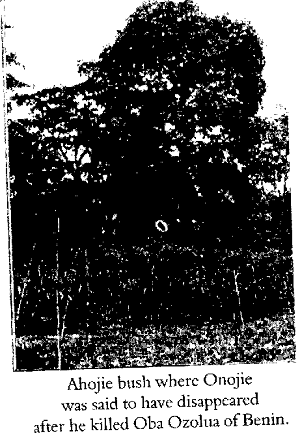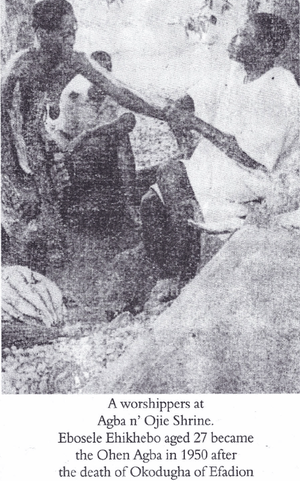Agba Nojie of Uromi
| Agba N'Ojie | |
|---|---|
| Onojie of Uromi | |
| Reign | 1483 - 1507 |
| Predecessor | Ichesan |
| Successor | Ikenoa |
| Born |
Uromi |
| Died |
Unknown Unknown |
| Father | Ichesan |
Agba N'Ojie of Uromi, originally called Agba, Agba N'Ojie (Esan God of War), was the Onojie|King of the Esan people from 1483 AD until 1507 AD. He was an important Onojie in the history of the Esan people. He created the independence Esanland from the old Benin Empire and stopped the tributes from Enijies in Esanland to be paid to the Oba of Benin and stopped any appeal cases been taken from Esanland to the Oba's Palace of Benin for retrial. During the time of Ozolua n'Ibarmoi (or Ozolua the Conqueror).
History
Agba N'Ojie inherited the Uromi Throne after the demise of his father Onojie Ichesan, the first Onojie of Uromi and was resolved to free his kin from the control of the old Benin Empire. The general population of Esan Kingdoms initially relocated from Benin City amid the rule of Oba Ewuare the Great. These atomic settlements extended by interior development and through recorded movements from Benin around five centuries back. Such movements into the zone were accepted to have even happened before and was driven by ousted sovereigns or boss, culprits and so on who had abandoned Benin City for the uninhabited woods lands "some time before 1460, that is Ewuare's reign as the Oba of Benin either through the self-centeredness and outrages of a portion of the Obas, or following the cataclysmic common wars over progression. Recorded relocation out of Benin City occurred amid Oba Ewuare's reign in the fifteenth century when the Oba lost his two children and ordered some unforgiving laws including restricting the subjects from cooking, washing or having sex for a long time. It was the hatred of individuals against the new way of life in Benin City that made individuals to move into the forest. The Oba tried to battled against the parties that have migrated into Esanland, however failed. Oba Ewuare's pugnacious nature drove him into vanquishing 201 towns and towns yet not Esanland. For a significant number of the scattered settlements in the Esanland, the Oba needed to utilize discretion to bring them under Benin dominion. He welcomed Esan pioneers or their agents to Benin for a détente. He dangled appealingly before them a connection to Benin City. He was prepared to perceive and respect his guests with the title of Onojie; which means King. There is no record of the individuals who may have gotten the invitation however disregarded it. They have vanished from history, for the future Esan laid on the individuals who went to Benin and took the title of Onojie. Agba's father was one of the pioneers that was installed by Oba Ewuare in 1463 as the first Onojie of Uromi. At the time when Agba assumed control over the position as the Onojie King after the passing of his father Onojie Ichesan found the way Oba Ewuare utilized discretion and manipulations to bring the Esan people under the Bini control, chooses to end the Bini control over the Esan people. So when Oba Ozolua , Ozolua n'Ibaromi (Ozolua the Conqueror) extended a hand of friendship to Agba Nojie of Uromi. King Agba of Uromi, bluntly and gallantly refused the friendship with the Oba, that it was not a fair weather friendship and a gesture, whose essence was dead on arrival… Certainly, that was like a blow to the ego of Oba Ozolua and as a result of that, a War was declared between two Generals,…. Oba Ozolua of Benin and Onojie Agba Nojie of Uromi. Which lead to the Benin Esan War.

Benin Esan War
During the 16th century, the Uzea War occurred which is called the Benin Esan War. This war was between the Uromi Kingdom and the Benin Kingdom. The war lasted for many years, as a result from a refusal of friendship from Oba Ozolua of Benin by Onojie Agba N'Ojie of Uromi. Oba Ozolua moved with his warriors to Esanland and beheaded the Onojie of Uzea during the war. The war ended at the town of Uzea, when Oba Ozolua was beheaded by Agba N'Ojie of Uromi and Oba Ozolua was buried in Esanland and while king Agba N'Ojie of Uromi on the other hand, never died immediately, rather vanished into Ahojie bush and was never seen till date and the people of Esan deified him as a God of WAR and is being worshipped today under a tall Kapok tree that is evergreen throughout the year. Note it was after that war that the original coinage of ESan Gbe Edo originated, Meaning Esan has defeated Benin in War. At that time, it was even used as a name among Esans as well. The Benin warriors went back home after the defeat, and narrated the intense dreadful nature and gallantry of Esans, the anger of cross quarrel and zest to fight again, led to the coinage by the Benin warriors, that where ever you see a snake and the Esan, kill the Esan first, but good enough, one of the Benin warriors was of an Esan mother, and he vehemently said that Esan can never Be killed, because they are enigmatic. However, in peaceful times as time evolved with more wars around the corner, for Esan and Benin to take care of, a Treaty of PEACE was signed Between Esans and the Benins, which the Esan Call ukoven which was done and sealed by planting the Ohimi tree, and pledged on the Ohimi oath, "Esan I Gbedo"....what is now Known today as "ESan Igbe Edo " meaning Esan will no longer attack Benin. Esan kingdoms would loan soldiers to the Benin Kingdom, such as during the Idah War of 1515-1516, as well, on three occasions, when Oba of Benins where denied, of their stool, they ran down to Esanland, and where led by Esan warriors, back to Benin, to reclaim their rightful stool as Oba example is Oba Osemwende (1816. - 1848).
Death
Agba N'Ojie of Uromi death was never confirmed because he vanished into Ahojie bush in Uromi and was never seen till date.

Alu-Agba Deity - Agba N'Ojie Shrine
Alu-Agba Deity is a God of WAR, worshipped today under a tall Kapok tree every Uromi main Market days by the Esan people. They believe that Agba N'Ojie has the power to protect them during War and Hard times.
See also
References
- J.U. Egharevba, "A Short History of Benin", Ibadan University Press, 1968.
- Okojie, A.T.A. "HRH OKOJIE I: The Man, the Myth and the Symbol" Lagos, Kope Publishers, 1997.
- "Tenancity of Gerontocracy in Nigeria – An Example of the Esan People in Edo State" by Anthony I. Okoduwa, Stud. Tribes Tribals, 3(2): 123–128 (2005).
- "Edo Folk Songs as Sources of Historical Reconstruction" by Charles O. Aluede and Abu A. Braimah, Stud. Tribes Tribals, 3(2): 123–128 (2005).
- Uromi Community New York – http://www.uromicommunity-ny.com/aboutus.html
- Prince Ernest Khuemen Okojie, "The Myth Behind A Great King", MINDEX Press Ltd, 2015.